Luminal bacteria recruit CD103+ dendritic cells into the intestinal epithelium to sample bacterial antigens for presentation
- PMID: 23395676
- PMCID: PMC4115273
- DOI: 10.1016/j.immuni.2013.01.009
Luminal bacteria recruit CD103+ dendritic cells into the intestinal epithelium to sample bacterial antigens for presentation
Abstract
CD103+ dendritic cells (DCs) carry bacteria from the small intestine and can present antigens to T cells. Yet they have not been recorded sampling luminal bacteria or presenting bacterial antigens in mesentery lymph nodes. We used 2-photon microscopy in live Cx3cr1(+/gfp) ×Cd11c-YFP mice to study these processes. At steady state, sparse CD103+ DCs occupied the epithelium. They patrolled among enterocytes while extending dendrites toward the lumen, likely using tight-junction proteins to penetrate the epithelium. Challenge with Salmonella triggered chemokine- and toll-like receptor (TLR)-dependent recruitment of additional DCs from the lamina propria (LP). The DCs efficiently phagocytosed the bacteria using intraepithelial dendrites. Noninvasive bacteria were similarly sampled. In contrast, CD103+ DCs sampled soluble luminal antigen inefficiently. In mice harboring CD103+ DCs, antigen-specific CD8 T cells were subsequently activated in MLNs. Intestinal CD103+ DCs are therefore equipped with unique mechanisms to independently complete the processes of uptake, transportation, and presentation of bacterial antigens.
Copyright © 2013 Elsevier Inc. All rights reserved.
Figures
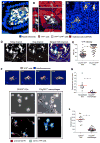
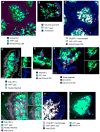
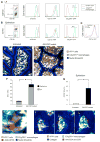
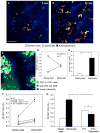
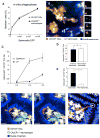

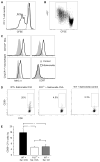
Similar articles
-
A new subset of CD103+CD8alpha+ dendritic cells in the small intestine expresses TLR3, TLR7, and TLR9 and induces Th1 response and CTL activity.J Immunol. 2011 Jun 1;186(11):6287-95. doi: 10.4049/jimmunol.1004036. Epub 2011 Apr 27. J Immunol. 2011. PMID: 21525388
-
Functional specialization of gut CD103+ dendritic cells in the regulation of tissue-selective T cell homing.J Exp Med. 2005 Oct 17;202(8):1063-73. doi: 10.1084/jem.20051100. Epub 2005 Oct 10. J Exp Med. 2005. PMID: 16216890 Free PMC article.
-
CX3CR1⁺ cells facilitate the activation of CD4 T cells in the colonic lamina propria during antigen-driven colitis.Mucosal Immunol. 2014 May;7(3):533-48. doi: 10.1038/mi.2013.70. Epub 2013 Oct 16. Mucosal Immunol. 2014. PMID: 24129164
-
How vitamin A metabolizing dendritic cells are generated in the gut mucosa.Trends Immunol. 2012 Jan;33(1):42-8. doi: 10.1016/j.it.2011.10.001. Epub 2011 Nov 11. Trends Immunol. 2012. PMID: 22079120 Review.
-
Development and functional specialization of CD103+ dendritic cells.Immunol Rev. 2010 Mar;234(1):268-81. doi: 10.1111/j.0105-2896.2009.00874.x. Immunol Rev. 2010. PMID: 20193025 Review.
Cited by
-
The microbiota is dispensable for the early stages of peripheral regulatory T cell induction within mesenteric lymph nodes.Cell Mol Immunol. 2021 May;18(5):1211-1221. doi: 10.1038/s41423-021-00647-2. Epub 2021 Mar 24. Cell Mol Immunol. 2021. PMID: 33762684 Free PMC article.
-
Microbiome-Stealth Regulator of Breast Homeostasis and Cancer Metastasis.Cancers (Basel). 2024 Aug 31;16(17):3040. doi: 10.3390/cancers16173040. Cancers (Basel). 2024. PMID: 39272898 Free PMC article. Review.
-
Intestinal CD103(+)CD11b(-) dendritic cells restrain colitis via IFN-γ-induced anti-inflammatory response in epithelial cells.Mucosal Immunol. 2016 Mar;9(2):336-51. doi: 10.1038/mi.2015.64. Epub 2015 Jul 15. Mucosal Immunol. 2016. PMID: 26174764 Free PMC article.
-
Neurotransmitters: The Critical Modulators Regulating Gut-Brain Axis.J Cell Physiol. 2017 Sep;232(9):2359-2372. doi: 10.1002/jcp.25518. Epub 2017 Apr 10. J Cell Physiol. 2017. PMID: 27512962 Free PMC article. Review.
-
Mechanisms and functions of intestinal vascular specialization.J Exp Med. 2024 Jan 1;221(1):e20222008. doi: 10.1084/jem.20222008. Epub 2023 Dec 5. J Exp Med. 2024. PMID: 38051275 Free PMC article. Review.
References
-
- Abreu MT. Toll-like receptor signalling in the intestinal epithelium: how bacterial recognition shapes intestinal function. Nat Rev Immunol. 2010;10:131–144. - PubMed
-
- Adachi O, Kawai T, Takeda K, Matsumoto M, Tsutsui H, Sakagami M, Nakanishi K, Akira S. Targeted disruption of the MyD88 gene results in loss of IL-1- and IL-18-mediated function. Immunity. 1998;9:143–150. - PubMed
-
- Anjuère F, Luci C, Lebens M, Rousseau D, Hervouet C, Milon G, Holmgren J, Ardavin C, Czerkinsky C. In vivo adjuvant-induced mobilization and maturation of gut dendritic cells after oral administration of cholera toxin. J Immunol. 2004;173:5103–5111. - PubMed
-
- Arques JL, Hautefort I, Ivory K, Bertelli E, Regoli M, Clare S, Hinton JC, Nicoletti C. Salmonella induces flagellin- and MyD88-dependent migration of bacteria-capturing dendritic cells into the gut lumen. Gastroenterology. 2009;137:579–587. e1–2. - PubMed
Publication types
MeSH terms
Substances
Grants and funding
LinkOut - more resources
Full Text Sources
Other Literature Sources
Molecular Biology Databases
Research Materials

